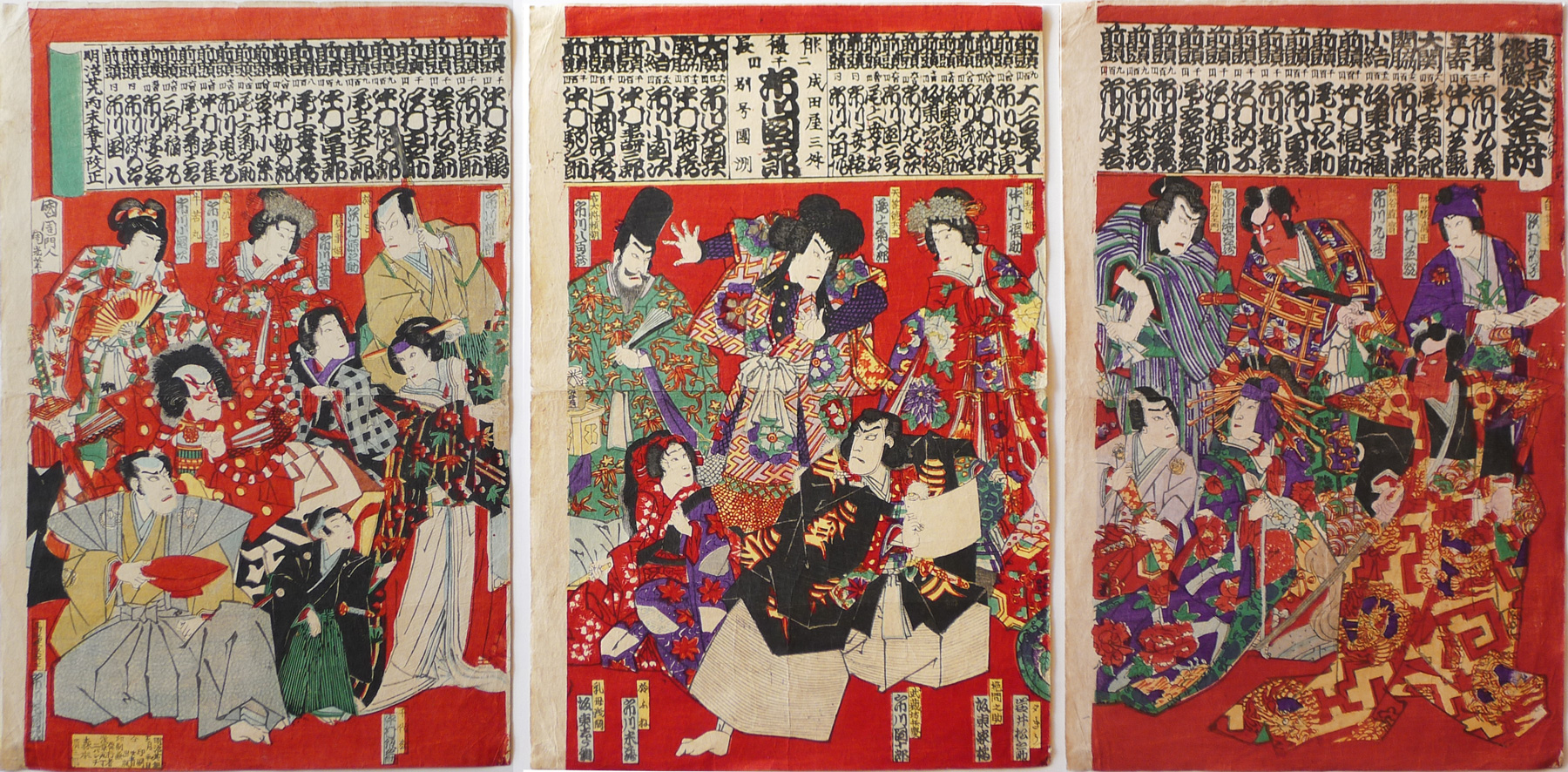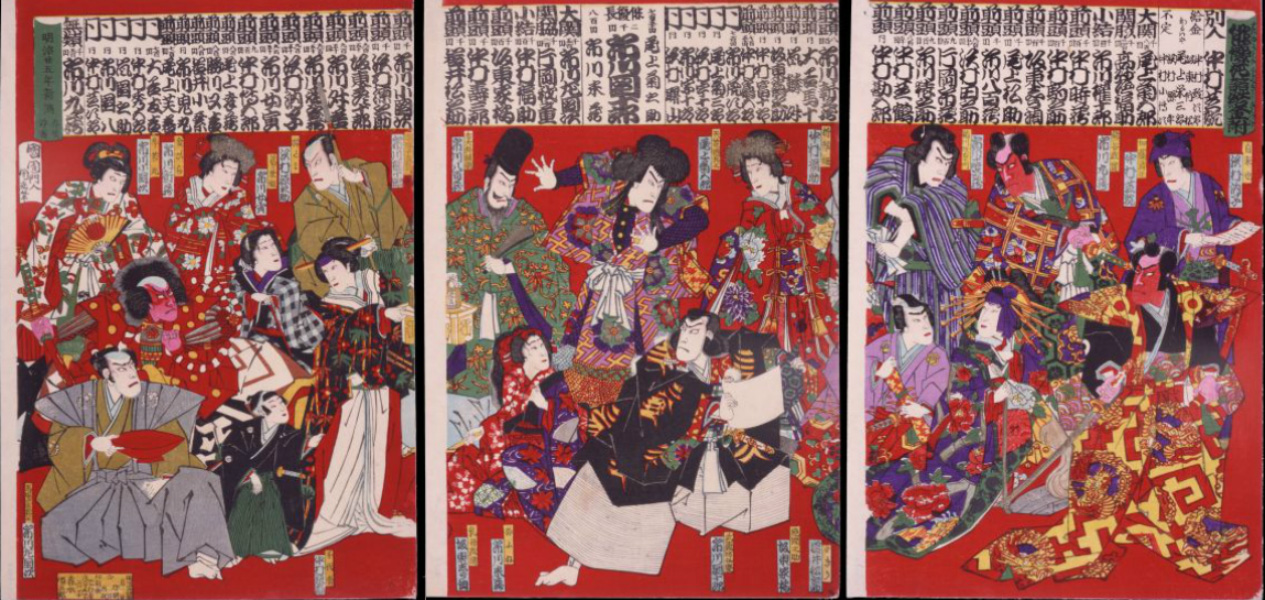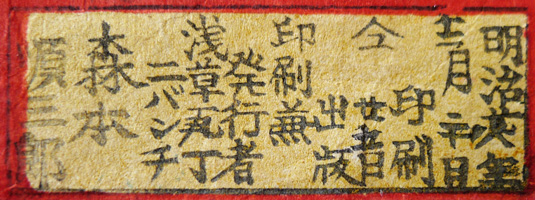About This Print
A depiction of nineteen actors in character, along with a listing of their salaries and the salaries of other leading Tokyo kabuki actors (see below). The leftmost entry on the scroll running across the top of the print provides a date of Meiji 29 (1896) for the annual salaries that are given above each actor's name.
It is interesting to compare these 1896 salaries with the salaries in the c. 1883 print by Chikamitsu's teacher Toyohara Kunichika (1835–1900) titled A Comparison of Actors' Wages (Tokyo) and an 1891 print in the collection of the Japan Arts Council that uses the exact same design of the actors in their roles as this collection's print, but with different written information in the scroll. (See image below of the Japan Arts Council print.)
Name Annual Salary
c. 1883 in yenAnnual Salary 1892 in yen Annual Salary 1896 in yen Ichikawa Danjurō IX 市川 團十郎 1,500 2,000 2,000 Ichikawa Gonjūrō I 市川権十郎 1,000 1,100 1,300 Ichikawa Kuzō III 市川九蔵 1,100 1,500 1,300 Ichikawa Sadanji I 市川左団次 1,100 1,500 1,600 Nakamura Fukusuke IV 中村 福助 1,200 1,100 1,100 Nakamura Shikan IV 中村芝翫 850 850 1,000 Onoe Kikugorō V 尾上菊五郎 1,300 1,600 1,600
A Similar Print Issued in 1892
This same design, picturing the same actors, was originally issued in 1891. The scroll across the top shows the salaries of top actors for the 1892 kabuki season.
The Actors Pictured in This Collection's Print
俳優花競給金附
国周門人周光筆 (周光 ちかみつ)
明治24年(1891)(出版)
森本 順三郎
click on image to enlarge
The Actors Pictured in This Collection's Print
The names and roles of the actors pictured, as given in the blue and yellow cartouches.
Right PanelTop row from right to left:
Sawamura Toshii VII 澤村 訥子 as Jiraiya 自来也 Ichikawa Kuzō III 市川 九蔵 (市川 團蔵 Ichikawa Danzō VII) as Kumagai Naomi 熊谷直実
Ichikawa Sumizō V 市川 寿美蔵 as the wrestler Inagawa Masaemon 稲川政右衛門
Bottom row from right to left:
Nakamura Shikan IV 中村 芝翫 as Katō Kiyomasa 加藤清正
Iwai Matsunosuke IV 岩井 松之助 as Yūgiri 夕ぎり [cartouche appears center panel]
Ichikawa Sumizō V 市川 寿美蔵 as the wrestler Inagawa Masaemon 稲川政右衛門
Bottom row from right to left:
Nakamura Shikan IV 中村 芝翫 as Katō Kiyomasa 加藤清正
Iwai Matsunosuke IV 岩井 松之助 as Yūgiri 夕ぎり [cartouche appears center panel]
Bandō Kakitsu I 坂東 家橘 as Taemanosuke 絶間之助 [cartouche appears center panel]
Ichikawa Gonjūrō 市川 権十郎 (Arashi Rikaku III 嵐 璃珏) as Mizuno Jūrōzaemon 水野十郎左衛門
Ichikawa Shinzō V 市川 新蔵 as Kimupira? 金ぴら
Bottom row from right to left:
Bandō Shūchō II 坂東 秀調 as Uba? Asaoka 乳母浅岡
Nakamura Ginnosuke II 中村 銀之助 as Chiyomatsu 千代松
Ichikawa Sadanji I 市川 左團次 as Baba Saburobei 馬場三郎兵衛
Center Panel
Top row from right to left:
Nakamura Fukusuke IV 中村 福助 (Nakamura Utaemon V 中村 歌右衛門) as Orikotōhime 折琴姫Onoe Kikugorō V 尾上 菊五郎 as Tenjiku Tokubē 天竺徳兵衛
Ichikawa Yaozō VII 市川 八百蔵 (Ichikawa Chūsha VII 市川 中車) as Udaishō Yoritomo 右大将頼朝
Bottom row from right to left:
Ichikawa Danjūrō IX 市川 團十郎 as Musashibō Benkei 武蔵坊弁慶
Ichikawa Yonezō III 市川 米蔵 (Fujima Kanjūrō 藤間 勘寿郎) as Ofune おふね
Left Panel
Top row from right to left:Ichikawa Gonjūrō 市川 権十郎 (Arashi Rikaku III 嵐 璃珏) as Mizuno Jūrōzaemon 水野十郎左衛門
Ichikawa Metora II 市川 女寅 (Ichikawa Monnosuke VI 市川 門之助) as Kazura no hahime? 葛ノ葉姫
Ichikawa Kodanji V 市川 小團次 as Ushiwakamaru 牛若丸
Center row from right to left:
Sawamura Gennosuke II 澤村 源之助 as Otomi おとみIchikawa Shinzō V 市川 新蔵 as Kimupira? 金ぴら
Bandō Shūchō II 坂東 秀調 as Uba? Asaoka 乳母浅岡
Nakamura Ginnosuke II 中村 銀之助 as Chiyomatsu 千代松
Ichikawa Sadanji I 市川 左團次 as Baba Saburobei 馬場三郎兵衛
For profiles of the actors please see the article The Kabuki Actor.
In discussing actor salaries at the beginning of the 19th century, Arendie and Henk Herwig state:
1 Private Academies of Chinese learning in Meiji Japan: The Decline and Transformation of the Kanguku Juku, Margaret Mehl, Nordic Institute of Asian Studies, 2003, p. xiv.
Actors' Wages
While there is some English language information available on both pre and post-Meiji salaries for kabuki actors, there seems to be little information available in English on salaries for Meiji-era kabuki actors. For the salaries shown on the print's scroll, they are likely yearly salaries as actors contracted with a theater for the entire kabuki season. On this print, the highest annual salary listed is that of Ichikawa Danjurō IX 市川団十郎 at 2,000 yen. As a point of reference, the basic starting pay of a policeman in 1881 was 72 yen per year and for an elementary school teacher in 1886, 60 yen.1In discussing actor salaries at the beginning of the 19th century, Arendie and Henk Herwig state:
| [T]op actors’ annual earnings were between 1000 and 1500 ryō2. According to Brandon3, 1000 ryō would be the equivalent of 400,000 to 800,000 American dollars today. They did have to pay for their own costly costumes, however. Popular actors received a formal salary, but they were also supported by wealthy patrons who provided extra revenue or paid for expensive costumes. In return, the patrons could expect favours such as the presence of actors at their parties or private performances. It was common practice for actors to honour their patrons with a visit during the first days of the New Year bringing gifts as tokens of gratitude.4 |
1 Private Academies of Chinese learning in Meiji Japan: The Decline and Transformation of the Kanguku Juku, Margaret Mehl, Nordic Institute of Asian Studies, 2003, p. xiv.
2 One pre-Meiji ryō was equal to one post-Meiji sen.
3 Kabuki Plays on Stage: Villainy and Vengance, 1773-1799, editors James R. Brandon, Samuel L. Leiter, University of Hawaii Press, 2003, p. 288.
4 Heroes of the Kabuki Stage: An Introduction to the World of Kabuki with Retellings of Famous Plays, illustrated by Woodblock Prints, Arendie Herwig and Henk J. Herwig, Hotei Publishing, 2004, p. 40.
3 Kabuki Plays on Stage: Villainy and Vengance, 1773-1799, editors James R. Brandon, Samuel L. Leiter, University of Hawaii Press, 2003, p. 288.
4 Heroes of the Kabuki Stage: An Introduction to the World of Kabuki with Retellings of Famous Plays, illustrated by Woodblock Prints, Arendie Herwig and Henk J. Herwig, Hotei Publishing, 2004, p. 40.
Print Details
| IHL Catalog | #1139 |
| Title (Description) | Ranking of Wages of Tokyo Actors 東京俳優給金附 Tokyo haiyū kyūkin zuke |
| Artist | Toyohara Chikamitsu (active c. 1891- 1896) |
| Signature |  |
| Seal | not sealed |
| Publication Date | 1895 明治廿八 |
| Publisher | 森本 順三郎 Morimoto Junzaburō [Marks: pub. ref. 349 seal not shown] reading from right to left: 明治廿八年十二月二十日 印刷 Meiji 28, 12th month, 20th day printed 明治廿八年十二月廿五日 出版 Meiji 28, 12th month, 25th day published 印刷兼発行者 浅草瓦丁二 八こ千 publisher and printer [followed by address] 森本 順三郎 Morimoto Junzaburō |
| Carver | not given |
| Impression | fair - poor registration |
| Colors | excellent |
| Condition | fair - full size; not backed; horizontal fold across centers of sheets; small tears; light wrinkling |
| Genre | ukiyo-e; yakusha-e |
| Miscellaneous | |
| Format | vertical oban triptych |
| H x W Paper | 14 3/8 x 9 3/4 in. (36.5 x 24.8 cm) each sheet |
| Literature | |
| Collections This Print | |




